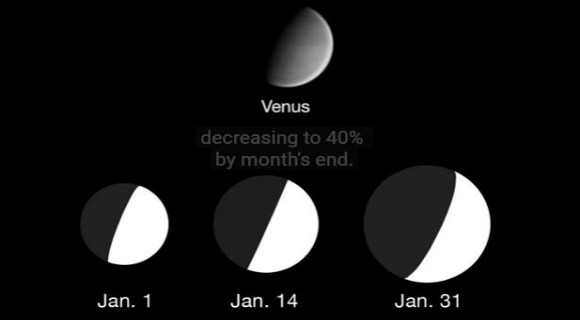VIDEO OF THE DAY: What’s Up In The Sky For January 2017
By NASA // January 4, 2017
ABOVE VIDEO: A comet, plus the moon, Venus, Mars and Quadrantid Meteor shower ring in the new year.
(NASA) – What’s Up for January 2017? Meteors from a demoted constellation, Venus high, comet 45P low and the best of Vesta.
The new year started with a beautiful view of the moon, Venus and Mars on January 1st, 2nd and 3rd. Venus shined at its brightest in many years.
Through a telescope you’ll see the disk 56 percent lit on January 1st, half lit on the 14th, decreasing to 40 percent by month’s end.
Most meteor showers radiate from recognizable constellations like Leo’s Leonids, Gemini’s Geminids and Orion’s Orionids. But the Quadrantids are meteors that appear to radiate from the location of the former Quadrans Muralis constellation.
In the early 1920s the International Astronomical Union divided up the sky into official constellations. 88 constellations remained, but over 30 historical constellations didn’t make the cut.

The Quadrans Muralis area of the sky is within the boundaries of the official constellation Boötes. The Quadrantids peak lasts for just a few hours.
Meteor showers are usually the residue that collects in the orbits of comets. The Quadrantids are associated with an asteroid — 2003 EH1.
It is thought to be the nucleus fragment from a comet break-up in the 1490s. It was classified as an asteroid when it was discovered by a near-Earth asteroid telescopic survey in 2003.
Two other notable objects are visible this month through telescopes and binoculars. Comet 45P is visible just after sunset at the beginning of the month very low in the southwestern sky, and will be visible just before sunrise by month’s end.
Vesta, the brightest of all the asteroids, is visible all month long, reaching opposition and its peak of brightness on January 17th. Use Gemini’s twin stars Castor and Pollux to find Vesta.
CLICK HERE FOR MORE NEWS FROM NASA













